Self-Corporal Image among People Living with HIV/AIDS with Lipodystrophy Syndrome in Brazil ()
1. Introduction
Recent advances in antiretroviral therapy (HAART) have resulted in reductions in HIV-related morbidity and mortality, even in developing countries [1]. Although this therapy increases the life expectancy of patients up to 37 years, it can cause side effects that can prevent treatment adherence [2]. The second most common effect is lipodystrophy syndrome (LDS), which consists of a set of changes organic and alterations in the redistribution of body fat [3]. LDS is characterized by the loss or accumulation of body fat, mainly in the abdominal and dorsal regions, and increases the volume of the woman’s breasts. The loss of fat and muscle mass has been observed in the peripheral region, located in the face, buttocks, arms and legs. Facial lipoatrophy is characterized by the loss of oral and/or temporal fat, leading to facial skeletonization with concave cheeks, prominent nasolabial folds, periorbital narrowing and visible facial muscles [4].
The body is the means by which the subject is in the world. It gives meaning and constitutes a person as a being in the world. Body image (BI) refers to a multifactorial construction that involves perception, thoughts, feelings, attitudes and behaviors related to oneself and other people. Composing the CI, satisfaction and self-perception are preponderant factors in the self-acceptance of individuals and can generate situations of dissatisfaction (differences between the perceived and the ideal body) and perceptual discrepancies (overestimation or underestimation of the entire BI or parts of it) [5].
Nowadays, with the increase in life expectancy among people living with HIV (PLHIV), the investigation of quality of life (in its multidimensionality) has become even more comprehensive, involving psychological, social and structural factors. In this sense, it is essential to analyze the biopsychosocial aspects involved in life satisfaction of PLHIV today [6].
Generally, body image formation is a dynamic and multidimensional process that influences and is influenced by social relationships and includes physiological and psychological aspects, physiological and psychological aspects [7]. In addition, body image is important in the psychological field as a factor that affects the patient’s reactionary dynamics and can lead to psychological and organic symptoms [8]. Changes in the body are visible, influencing relationships with others and self-perception. These changes represent an attack on bodily and psychic integrity, leading to feelings of inadequacy and enhancing attitudes of isolation, inhibition and apathy [9]. These feelings can vary in intensity according to the severity of the bodily change and subjective meaning of the body and meaning of social partners related to bodily and social patterns.
LDS can modify the body image and self-esteem of patients on HAART. Thus, lipodystrophy can result in significant distortions in body image due to changes in the physical body. Consequently, this modification can lead to emotional conflicts in these patients’ lives. Therefore, while HAART produces improvement and hope for the control of HIV disease, it can also have important emotional consequences. Thus, the aim of the present study was to assess the effects of LDS on self-esteem and body image of PLHIV in Brazil.
2. Methods
In a retrospective study with 180 patients seen at the HIV-Out ADEE 3002 outpatient clinic of the Dermatology Outpatient Clinic of the Central Institute of a University Hospital in São Paulo in 2006, 16 were invited to participate, of both sexes, with use of HAART for at least six months. They were informed about the purpose of the study; signed the Free and Informed Consent Term and the study was approved by the Institution’s Research Ethics Committee.
The sample included 16 PLWHIV (Eight men and eight women), with a mean age of 40 years, representing about 10% of the cohort. All cases showed visible signs of LDS (lipodystrophy), self-reported by the patient regarding changes in the redistribution of body fat after HIV diagnosis, according to the “SMART study” [10] and a tool used in a study carried out by Soares LR [11].
A semi-structured, semi-directed individual psychological interview was carried out in a quiet place, with a guarantee of confidentiality, which was analyzed using the Operational Adaptive Diagnosis Scale (EDAO) [12] and patients were asked to produce each of the two drawings below: one representing the body image in the view of the clinical picture (lipodystrophy or facial atrophy) and the other representing the current body image.
The analysis of the drawings was based on the psychoanalytic method and the patients completed the Body Image Scale [13], in which the scale items include emotional and behavioral aspects; half of the items have a positive presentation and the other half a negative presentation. The scores for each item are added together to create a total score, with values ranging from 0 to 30. Low scores represent little or no distress or symptoms associated with body image, and high scores indicate the presence of distress.
The objective of the interview was to collect information about the patient’s perception of the disease and treatment, self-esteem and changes in life after the diagnosis of lipodystrophy.
3. Results
Operational Adaptive Diagnosis Scale (EDAO) revealed that HIV and LDS are serious problems for 56% and very serious problems for 44% of patients, justified by reports (88%) that there is currently no cure for AIDS. HIV/AIDS treatment has changed patients’ lives; 50% of patients reported physical problems and 25% reported consequences in the family and social sphere. They also revealed that bodily changes, family problems and social prejudices increased after treatment. Regarding self-esteem, 88% of patients were “little adjusted” to their condition, reporting low self-esteem. For 63% of patients, physical appearance was a concern and 87% of them reported body dissatisfaction. Patients also reported an impact on their sexuality; 75% of patients felt they were less attractive and 88% reported reduced libido after the onset of LDS.
3.1. Qualitative Analysis Based on Body Image Drawings
The patients’ drawings demonstrated the high impact of the disease on their body images. The “earlier designs” indicated that HIV was an occult condition present only in the blood. Then, lipodystrophy, presented by the “post-drawings”, announced the previously hidden condition. Several drawings are illustrated below.
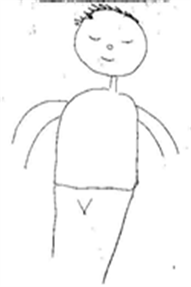
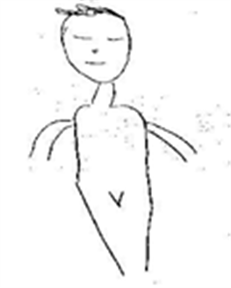
Before After
“I have felt the effect of lipodystrophy since 1999, first on the face, now on the entire body, with a lot of weight loss; it changed my self-esteem” (N.N.S, 34 years old, case 1).
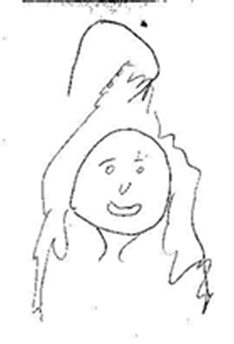

Before After
“Worse than having HIV is having lipodystrophy; I can’t work because of my appearance, which has been heavily modified, and today, I look like a monster” (L.R., 41, case 2).


Before After
“My appearance has changed a lot, and that bothers me; maybe if my appearance didn’t change no one would notice that I have HIV. Before I was beautiful, today my face is very marked” (EF, 43 years old, case 10).
3.2. Quantitative Analysis Based on Interview, EDAO and Body Image Scale
The sample included 16 patients (8 men and 8 women), with a mean age of 40 years, representing about 10% of the cohort. All cases had visible signs of LDS. All patients completed at least eight years of schooling, but none of them had a postgraduate degree. Most patients received minimum wage (US $250) and 31% of them received support. The subjects also reported that they were not physically and psychologically able to exercise a profession. Half of the patients were single or widowed. Widowhood was caused by the loss of a partner to AIDS. Single patients stated that this marital status was due to the disease (HIV infection), as they did not relate after the discovery of the disease. In addition, single status was exacerbated after the appearance of signs of lipodystrophy.
EDAO revealed that HIV infection and LDS are serious problems for 56% and very serious problems for 44% of patients, justified by reports (88%) that there is currently no cure for AIDS. Regarding self-esteem, 88% of patients were “little adjusted” to their condition, reporting low self-esteem. For 63% of patients, physical appearance was a concern and 87% of them reported body dissatisfaction. Patients also reported an impact on their sexuality; 75% of patients felt they were less attractive and 88% reported reduced libido after the onset of LDS.
3.3. Qualitative Analysis Based on Body Image Drawings
The patients’ drawings demonstrated the high impact of the disease on their body images. The “earlier designs” indicated that HIV was an occult condition present only in the blood. Then, lipodystrophy, presented by the “post-drawings”, announced the previously hidden condition. Several drawings are illustrated below.
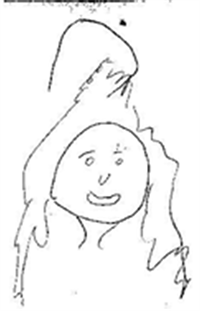

Before After
“I feel the effect of lipodystrophy since 1999, first on the face, now on the entire body, with a lot of weight loss; it changed my self-esteem” (N.N.S, 34 years old, case 1).
More about this source text Source text required for additional translation information
“Worse than having HIV is having lipodystrophy; I can’t work because of my appearance, which has been heavily modified, and today, I look like a monster” (L.R., 41, case 2).

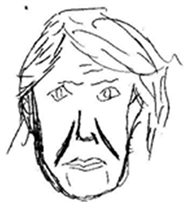
Before After
“My appearance has changed a lot, and that bothers me; maybe if my appearance didn’t change no one would notice that I have HIV. Before I was beautiful, today my face is very marked” (EF, 43 years old, case 10).
4. Discussion
Arguably, ART promoted greater life expectancy among people living with HIV, but it is associated with greater body adiposity and chronic inflammatory state that cause a series of endocrine-metabolic abnormalities [14]. These drugs, although considered by many people as “miraculous”, have an important side effect that causes physical and psychological damage to patients, affecting their quality of life (QL) [15]. In fact, QoL has been widely studied among HIV-infected individuals, especially those with LDS, and has been strongly correlated with LDS severity [16].
LDS has no direct effect on immune status; therefore, it is often overlooked by physicians and patients. But it can decrease adherence to HAART, daily activities and worsen QoL, possibly because of the resulting physical changes [13]. In fact, the value of physical attributes in social life can stigmatize subjects, distancing the ideal self from the real self and the self expected by others [17]. HIV/AIDS is stigmatized in our society and the anguish of bodily transformation is quite intense, especially among those who prefer to hide the disease. A study with 227 adults living with HIV at the ADEE3002-HCFMUSP outpatient clinic revealed a negative impact of lipodystrophy in relation to the body image of volunteers, where females were more critical at the time of self-assessment, attributing lower grades [18]. This conflict arises when the patient attributes facial changes to aging, not considering the treatment as the cause of bodily changes, as observed in current findings.
However, there are few studies involving facial lipoatrophy, but one developed in Spain with 62 patients shows that 71% of patients were men with an average age of 40 years and points out that, in relation to gender, male individuals had a greater tendency to develop lipoatrophy and are more prone to fat loss in peripheral regions of the body, while the opposite sex accumulates fat in central regions [19].
According to the current study, LDS is socially uncomfortable because bodily changes can be seen by others. Body construction is supported through personal experiences and social standards, leading to the continuous development and reassessment of one’s own image. Body assessment occurs through interaction with the environment and pressure to achieve (or at least try to achieve) the ideal body established by cultural standards of aesthetics [20]. As noted earlier, LDS patients were twice as likely to feel recognizable as HIV-positive by their physical appearance. LDS can therefore be perceived as a hallmark of HIV status for affected people. Therefore, stigmatization and social disadvantages can be consequences of LDS [17].
Because of LDS, these patients no longer conform to the aesthetic standards of the culture and felt “little fit.” They reported that it was impossible to look in the mirror, date, get a job or have a physical and emotional relationship with a partner. These data suggest that the consequences of LDS, including bodily deformities, can cause distress. In all cases in the present study, the drawings demonstrated the presence of psychological conflict, possibly related to bodily changes. In fact, these patients reported high stress due to the association between LDS and the exposure of HIV-seropositive carriers. In addition, adherence to HAART and clinical follow-up are affected by the presence of adipose tissue alterations. Higher adherence level is associated with greater risk of subsequent LDS; therefore, the onset of morphological changes perceived by the patient may reduce adherence to HAART [21].
The present study also found that 88% of patients reported reduced libido after the onset of LDS. This factor illustrates the influence of body image on sexuality, evidenced by body disorders (“ugly”) and no longer desirable, which compromise sexual activities. A decrease in the pleasure of sex and sexual activity was also observed in previous research, although it was not possible to determine whether this decrease was caused by LDS, other aspects of HAART, or both [20].
Importantly, most patients (94%) reported a preference to suffer from all the consequences of the disease (including LDS), attributing this choice as an “option to live”. Although it was not our objective, the importance of psychological treatment to help these patients in coping with the HIV diagnosis and body image was evident. Similar findings were seen in Asia, where changes in body shape affected mood by 36%, work and/or social activities by 23%, but only <1% of affected individuals reported a desire to discontinue HAART because of these changes [22]. Facial lipoatrophy is a stigmatizing feature of LDS, as the face is typically perceived as an indicator of health and cannot be hidden. Previous research has also observed the negative psychosocial impact and impairment of QoL in the LDS due to self-image and self-esteem disorders, leading to depression and social and sexual problems [16].
Thus, for HIV-infected subjects, identifying and monitoring LDS and low self-esteem in relation to individuals living with other chronic diseases is necessary. One study revealed that the interruption of treatment increased cardiovascular complications by approximately 70%. In addition, cardiovascular events were five more likely to develop opportunistic infections in those with HAART interruption [15]. The negative combination of morphological changes, with loss of self-esteem, can socially impact the individual with consequences associated with HIV infection and stigma, which can be a fatal combination for this vulnerable population. The data from this study emphasize the need for antiretrovirals and in fact, we evaluated using mainly integrase inhibitors, which has changed this result a lot in recent years.
Acknowledgements
We dedicate this work to all our patients over the last 30 years and to former medical residents, and we thank the volunteers Maria Olimpia Ribeiro Freitas and Maria Tereza de Figueiredo for more than 20 years of work in the Ambulatório de Imunodeficiências Secundárias do Hospital das Clínicas. To the collaborators of the Medical Research Laboratory—LIM56 of the Institute of Tropical Medicine of the University of São Paulo: Noemia Orii, José Eduardo Martins, and Daniel Lopes.
Ethical Approval
The University of Sao Paulo Ethical Committee approved this research. The ethical commission of the Institute of Tropical Medicine of São Paulo also approved the protocol.
Informed Consent
All patients provided verbal informed consent during the phone interview and have allowed the use of their data.
Informed Consent for Publications
All authors allowed publication of these data and read the final version of this manuscript.
Support
Fapesp 2020/05984-2; Fundação Faculdade de Medicina (FFM); CNPq Scholarship: Grant 301275/2019-0 to JC.
Authorship
PF: Organized the database and sent the electronic questionnaire to patients; LRS: Revision of the literature and discussion; General supervision; JC: Concept and discussion.